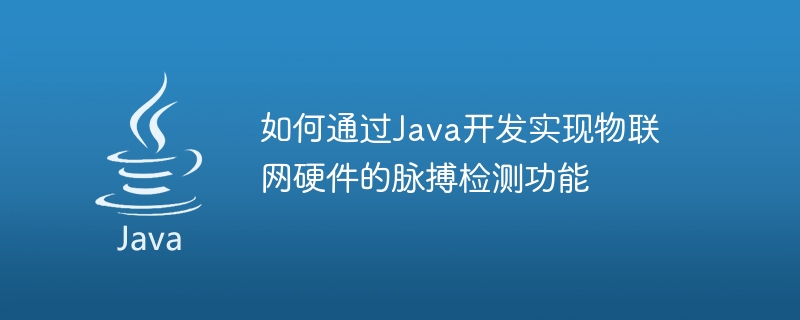Home >Java >javaTutorial >How to implement the pulse detection function of IoT hardware through Java development
How to implement the pulse detection function of IoT hardware through Java development
- 王林Original
- 2023-09-21 13:58:43734browse

How to implement the pulse detection function of IoT hardware through Java development
The emergence of IoT technology allows us to connect various physical devices through the Internet to achieve Intelligent control and monitoring. Among them, the pulse detection function of IoT hardware has important applications in the medical industry and health monitoring fields. This article will introduce how to implement the pulse detection function of IoT hardware through Java development, and attach specific code examples.
First of all, we need to clarify the principles and methods of pulse detection. Pulse detection is a technology that obtains information such as heart rate and pulse waveform by measuring the human body's heartbeat signal. Usually, we use heart rate sensors to monitor heartbeat signals, and transmit the collected data through IoT devices to the backend system for analysis and processing.
To implement the pulse detection function in Java development, you first need to choose a suitable IoT hardware platform and heart rate sensor. Common IoT hardware platforms include Arduino, Raspberry Pi, etc., while heart rate sensors include Pulse Sensor, Heart Rate Click, etc. While selecting hardware equipment, we also need to prepare the corresponding development environment and tools.
Next, we obtain the heart rate sensor data through Java code and process it. The following is a sample code:
import com.pi4j.io.gpio.GpioController;
import com.pi4j.io.gpio.GpioFactory;
import com.pi4j.io.gpio.GpioPinDigitalInput;
import com.pi4j.io.gpio.PinPullResistance;
import com.pi4j.io.gpio.RaspiPin;
import com.pi4j.util.Console;
public class PulseDetector {
public static void main(String[] args) throws InterruptedException {
final Console console = new Console();
// 获取GPIO控制器
final GpioController gpio = GpioFactory.getInstance();
// 以Raspberry Pi的GPIO引脚4作为输入引脚,连接心率传感器
final GpioPinDigitalInput sensor = gpio.provisionDigitalInputPin(RaspiPin.GPIO_04, PinPullResistance.PULL_DOWN);
// 初始化变量
int rateSampleCounter = 0;
int peakCounter = 0;
int beatRate = 0;
// 无限循环读取传感器数据
while (true) {
if (sensor.isHigh()) {
rateSampleCounter++;
}
if (sensor.isLow() && rateSampleCounter > 8) {
peakCounter++;
rateSampleCounter = 0;
}
// 计算心率
if (peakCounter >= 2) {
beatRate = 60000 / ((peakCounter - 1) * 10);
console.println("Heart Rate: " + beatRate + " beats per minute");
peakCounter = 0;
}
Thread.sleep(10);
}
}
}This sample code uses the Pi4J library on the Raspberry Pi to operate the GPIO pins to achieve the function of continuously monitoring the heartbeat signal. In the code, we use an infinite loop to obtain data from the heart rate sensor, calculate the heart rate by detecting the high and low levels of the sensor signal and output the result.
It should be noted that this sample code only demonstrates the basic implementation method of the pulse detection function. In actual applications, real-time transmission and storage of data, as well as possible data analysis and processing, are also required. In addition, the specific usage of the hardware platform and heart rate sensor may be different. Please make corresponding adjustments and modifications according to the actual situation.
To sum up, implementing the pulse detection function of IoT hardware through Java development requires selecting the appropriate hardware platform and heart rate sensor, and writing the corresponding code to obtain sensor data and process it. With the continuous development and maturity of IoT technology, IoT applications will play an increasingly important role in various fields, and the pulse detection function of IoT hardware will have broader application prospects in the medical and health monitoring fields.
The above is the detailed content of How to implement the pulse detection function of IoT hardware through Java development. For more information, please follow other related articles on the PHP Chinese website!

